2005 Seat Ibiza 5D maintenance
[x] Cancel search: maintenancePage 35 of 252
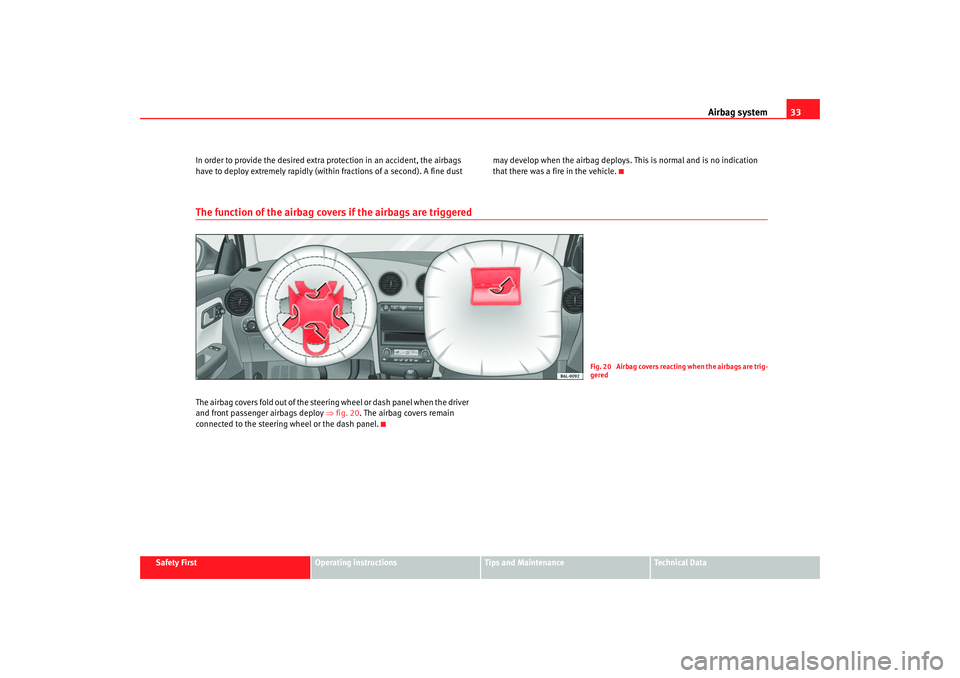
Airbag system33
Safety First
Operating instructions
Tips and Maintenance
Te c h n i c a l D a t a
In order to provide the desired extra protection in an accident, the airbags
have to deploy extremely rapidly (within
fractions of a second). A fine dust may develop when the airbag deploys. Th
is is normal and is no indication
that there was a fire in the vehicle.
The function of the airbag covers if the airbags are triggeredThe airbag covers fold out of the steering wheel or dash panel when the driver
and front passenger airbags deploy ⇒fig. 20 . The airbag covers remain
connected to the steering wheel or the dash panel.
Fig. 20 Airbag covers reacting when the airbags are trig-
gered
ibiza_ingles Seite 33 Mittwoch, 5. Oktober 2005 5:17 17
Page 37 of 252

Airbag system35
Safety First
Operating instructions
Tips and Maintenance
Te c h n i c a l D a t a
The airbag system is not a substitute for seat belts, but is an integral part of
the vehicle's overall passive safety system. Please bear in mind that the
airbag system can only work effectively when the occupants are wearing their
seat belts. For this reason, it is most important to wear the seat belts at all
times - not only because this is required
by law in most countries, but also for
your safety ⇒page 17, “Introduction”.
The side airbag system will not be triggered
•
if the ignition is switched off,
•
during a minor side collision,
•
during a minor frontal collision,
•
during a rear-end collision,
•
or if the vehicle rolls.
The main parts of the airbag system are
•
an electronic control and monitoring system (control unit),
•
the side airbags in the sides of the backrests of the front seats,
•
a warning lamp
in the dash panel insert ⇒page 29.
The functionality of the airbag system is monitored electronically. The airbag
warning lamp will light up for approx. 4 seconds every time the ignition is
switched on (self-diagnosis).
WARNING
•
In a side-on collision, the side air bags will not work, if the sensors do
not correctly measure the pressure incr ease on the interior of the doors,
due to air escaping through the areas with holes or openings in the door
panel.
•
Never drive the vehicle if the interior panels have been removed.
•
Never drive if the interior door panels have been removed or if the
panels have not been correctly fitted.
•
Never drive the vehicle if the loudspeakers in the door panels have
been removed, unless the holes left by the loudspeakers have been
correctly closed.
•
Always check that the openings are closed or covered if loudspeakers
or other equipment are fitted in the interior door panels.
•
Any work carried out to the doors should be made in a qualified author-
ised workshop.
•
The seat belts and airbags can only provide maximum protection if the
occupants are seated correctly ⇒ page 9, “Proper sitting position for occu-
pants”.
•
If a fault should occur in the airbag system, have the system checked
immediately by a qualified workshop. Otherwise there is a danger that
during a side collision, the system may fail to trigger, or not trigger
correctly.WARNING (continued)
ibiza_ingles Seite 35 Mittwoch, 5. Oktober 2005 5:17 17
Page 39 of 252

Airbag system37
Safety First
Operating instructions
Tips and Maintenance
Te c h n i c a l D a t a
Safety notes on the operation of the side airbag system
I f a i r b a g s a re u s e d c o r r e c t l y , t h e y c a n c o n s i d e ra b l y re d u c e t h e
risk of injury in side impact collisions.
WARNING
•
If you do not wear a seat belt, if you lean forward, or are not seated
correctly while the vehicle is in motion , you are at greater risk of injury
should the side airbag system be triggered in an accident.
•
In order for the side airbags to provide their maximum protection, the
prescribed sitting position must alwa ys be maintained with seat belts
while travelling.
•
Occupants of the outer seats must never carry any objects or pets in the
deployment space between them and th e airbags, or allow children or
other passengers to travel in this position. It is also important not to attach
any accessories (such as cup holders) to the doors. This would impair the
protection offered by the side airbags.
•
The built-in coat hooks should be used only for lightweight clothing. Do
not leave any heavy or sharp-edged objects in the pockets.
•
Great forces, such as hard blows or kicks, must not be exerted upon the
backrest bolster because the system may be damaged. In this case the side
airbags would not be triggered.
•
Under no circumstances should protective covers be fitted over the
driver seat or front passenger seat unless the covers have been expressly
approved for use in your vehicle. Because the airbag deploys from the side
of the backrest, the use of non-approved seat covers would obstruct the
side airbag seriously reducing the airbag's effectiveness ⇒page 162,
“Accessories, parts replacement and modifications”.
•
Any damage to the original seat uphol stery or around the seams of the
side airbag units must be repaired immediately by a qualified workshop.
•
The airbags provide protection for one accident only, if they have been
deployed they must be replaced.
•
When children assume an incorrect sitting position, they expose them-
selves to an increased risk of injury in the event of an accident. This is
particularly the case if the child is travelling on the front passenger seat
and the airbag system is triggered in an accident; this could have critical
consequences including serious injury or death ⇒page 43, “Child safety”.
•
Any work on the side airbag system or removal and installation of the
airbag components for other repairs (such as removal of the front seat)
should only be performed by qualified workshop. Otherwise, a fault may be
introduced into the operation of the airbag system.
•
Do not attempt to modify components of the airbag system in any way.
•
The side and head airbags are managed through sensors located in the
interior of the front doors. To ensure the correct functioning of the side and
head airbags neither the doors nor the door panels should be modified in
any way (e.g. fitting loudspeakers). If the front door is damaged in any way,
this may affect the correct working of the system. All work carried out on
the front door must be made in a qualified workshop.WARNING (continued)
ibiza_ingles Seite 37 Mittwoch, 5. Oktober 2005 5:17 17
Page 41 of 252
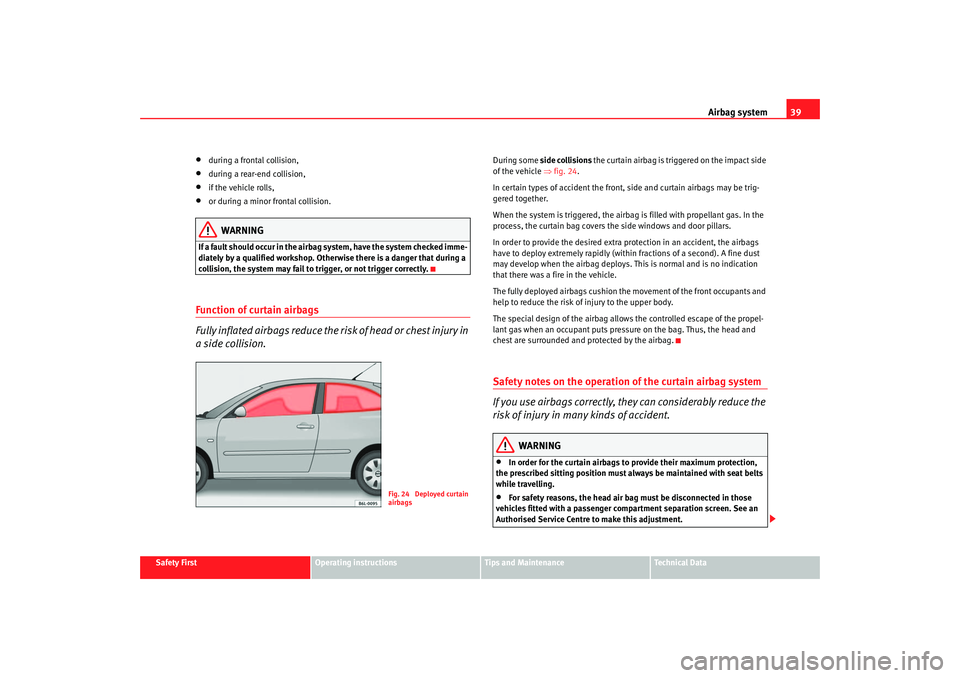
Airbag system39
Safety First
Operating instructions
Tips and Maintenance
Te c h n i c a l D a t a
•
during a frontal collision,
•
during a rear-end collision,
•
if the vehicle rolls,
•
or during a minor frontal collision.
WARNING
If a fault should occur in the airbag system, have the system checked imme-
diately by a qualified workshop. Otherw ise there is a danger that during a
collision, the system may fail to trigger, or not trigger correctly.Function of curtain airbags
Fu ll y i n fl a ted a i rb ag s redu ce t h e r i s k o f h ea d o r ch est i n ju r y i n
a side collision.
During some side collisions the curtain airbag is triggered on the impact side
of the vehicle ⇒fig. 24.
In certain types of accident the front, side and curtain airbags may be trig-
gered together.
When the system is triggered, the airbag is filled with propellant gas. In the
process, the curtain bag covers the side windows and door pillars.
In order to provide the desired extra protection in an accident, the airbags
have to deploy extremely rapidly (within fractions of a second). A fine dust
may develop when the airbag deploys. Th is is normal and is no indication
that there was a fire in the vehicle.
The fully deployed airbags cushion the movement of the front occupants and
help to reduce the risk of injury to the upper body.
The special design of the airbag allows the controlled escape of the propel-
lant gas when an occupant puts pressure on the bag. Thus, the head and
chest are surrounded and protected by the airbag.Safety notes on the operation of the curtain airbag system
If you use airbags correctly, they can considerably reduce the
risk of injury in many kinds of accident.
WARNING
•
In order for the curtain airbags to provide their maximum protection,
the prescribed sitting position must al ways be maintained with seat belts
while travelling.
•
For safety reasons, the head air bag must be disconnected in those
vehicles fitted with a passenger compartment separation screen. See an
Authorised Service Centre to make this adjustment.
Fig. 24 Deployed curtain
airbags
ibiza_ingles Seite 39 Mittwoch, 5. Oktober 2005 5:17 17
Page 43 of 252
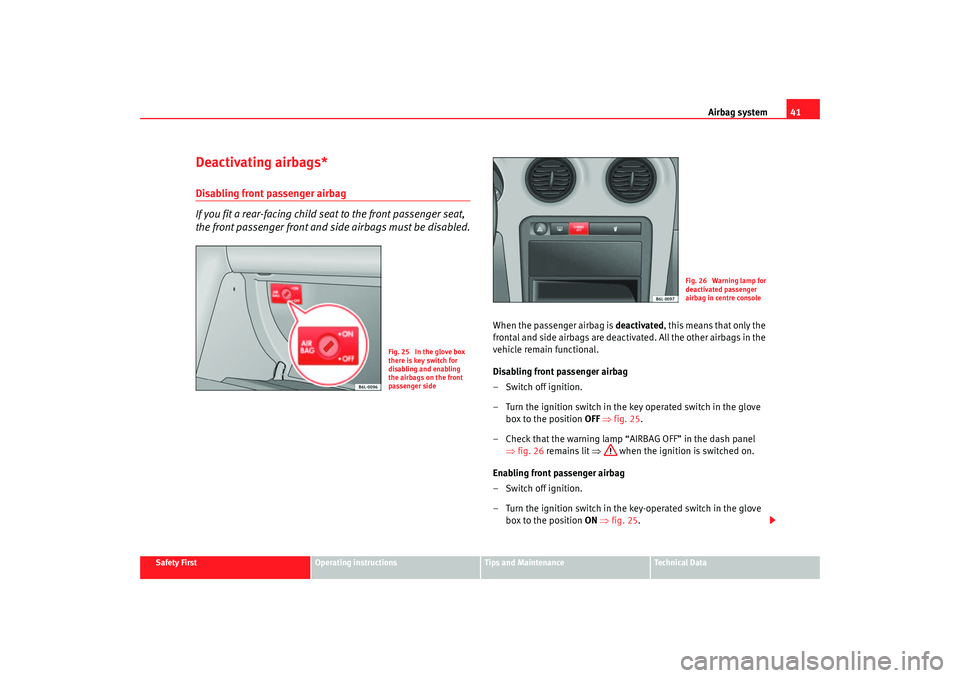
Airbag system41
Safety First
Operating instructions
Tips and Maintenance
Te c h n i c a l D a t a
Deactivating airbags*Disabling front passenger airbag
If you fit a rear-facing child seat to the front passenger seat,
the front passenger front and side airbags must be disabled.
When the passenger airbag is deactivated, this means that only the
frontal and side airbags are deactivated. All the other airbags in the
vehicle remain functional.
Disabling front passenger airbag
– Switch off ignition.
– Turn the ignition switch in the key operated switch in the glove box to the position OFF ⇒ fig. 25 .
– Check that the warning lamp “AIRBAG OFF” in the dash panel ⇒fig. 26 remains lit ⇒when the ignition is switched on.
Enabling front passenger airbag
– Switch off ignition.
– Turn the ignition switch in the key-operated switch in the glove box to the position ON ⇒ fig. 25 .
Fig. 25 In the glove box
there is key switch for
disabling and enabling
the airbags on the front
passenger side
Fig. 26 Warning lamp for
deactivated passenger
airbag in centre console
ibiza_ingles Seite 41 Mittwoch, 5. Oktober 2005 5:17 17
Page 45 of 252
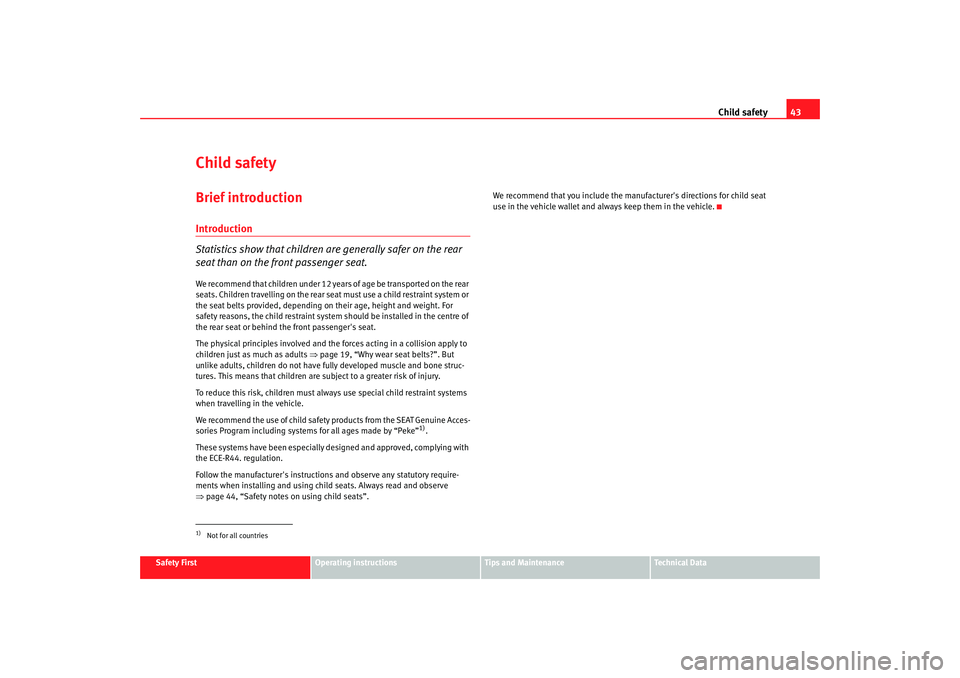
Child safety43
Safety First
Operating instructions
Tips and Maintenance
Te c h n i c a l D a t a
Child safetyBrief introductionIntroduction
Statistics show that children are generally safer on the rear
seat than on the front passenger seat.We recommend that children under 12 years of age be transported on the rear
seats. Children travelling on the rear seat must use a child restraint system or
the seat belts provided, depending on their age, height and weight. For
safety reasons, the child restraint system should be installed in the centre of
the rear seat or behind the front passenger's seat.
The physical principles involved and the forces acting in a collision apply to
children just as much as adults ⇒page 19, “Why wear seat belts?”. But
unlike adults, children do not have fully developed muscle and bone struc-
tures. This means that children are subject to a greater risk of injury.
To reduce this risk, children must always use special child restraint systems
when travelling in the vehicle.
We recommend the use of child safety products from the SEAT Genuine Acces-
sories Program including systems for all ages made by “Peke”
1).
These systems have been especially designed and approved, complying with
the ECE-R44. regulation.
Follow the manufacturer's instructions and observe any statutory require-
ments when installing and using child seats. Always read and observe
⇒ page 44, “Safety notes on using child seats”. We recommend that you include the manufacturer's directions for child seat
use in the vehicle wallet and always keep them in the vehicle.
1)Not for all countries
ibiza_ingles Seite 43 Mittwoch, 5. Oktober 2005 5:17 17
Page 47 of 252
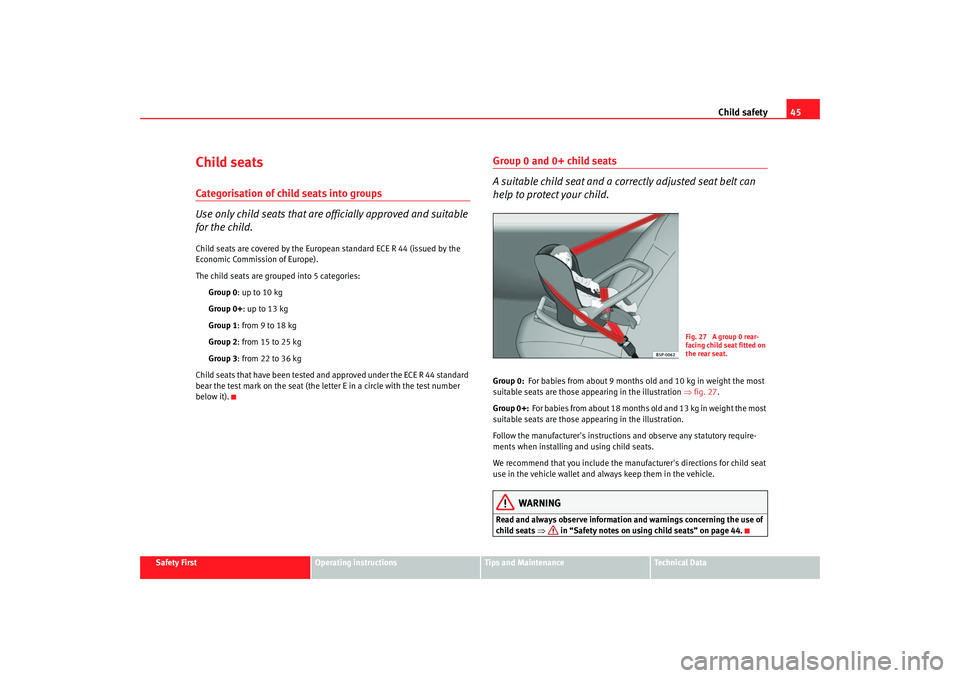
Child safety45
Safety First
Operating instructions
Tips and Maintenance
Te c h n i c a l D a t a
Child seatsCategorisation of child seats into groups
Use only child seats that are officially approved and suitable
for the child.Child seats are covered by the European standard ECE R 44 (issued by the
Economic Commission of Europe).
The child seats are grouped into 5 categories:
Group 0: up to 10 kg
Group 0+ : up to 13 kg
Group 1: from 9 to 18 kg
Group 2: from 15 to 25 kg
Group 3: from 22 to 36 kg
Child seats that have been tested and approved under the ECE R 44 standard
bear the test mark on the seat (the letter E in a circle with the test number
below it).
Group 0 and 0+ child seats
A suitable child seat and a corr ectly adjusted seat belt can
help to protect your child.Group 0: For babies from about 9 months old and 10 kg in weight the most
suitable seats are those appearing in the illustratio n ⇒ fig. 27.
Group 0+: For babies from about 18 months old and 13 kg in weight the most
suitable seats are those ap pearing in the illustration.
Follow the manufacturer's instructio ns and observe any statutory require-
ments when installing and using child seats.
We recommend that you include the manufacturer's directions for child seat
use in the vehicle wallet and always keep them in the vehicle.
WARNING
Read and always observe information and warnings concerning the use of
child seats ⇒ in “Safety notes on using child seats” on page 44.
Fig. 27 A group 0 rear-
facing child seat fitted on
the rear seat.
ibiza_ingles Seite 45 Mittwoch, 5. Oktober 2005 5:17 17
Page 49 of 252
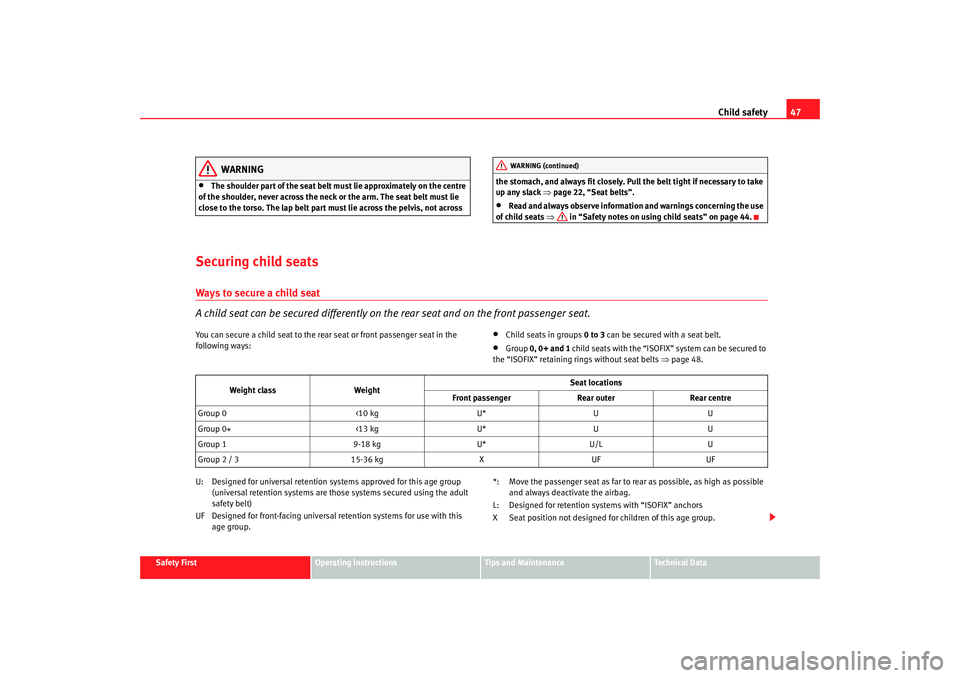
Child safety47
Safety First
Operating instructions
Tips and Maintenance
Te c h n i c a l D a t a
WARNING
•
The shoulder part of the seat belt mu st lie approximately on the centre
of the shoulder, never across the neck or the arm. The seat belt must lie
close to the torso. The lap belt part must lie across the pelvis, not across the stomach, and always fit closely. Pull the belt tight if necessary to take
up any slack ⇒
page 22, “Seat belts”.
•
Read and always observe information and warnings concerning the use
of child seats ⇒ in “Safety notes on using child seats” on page 44.
Securing child seatsWays to secure a child seat
A child seat can be secured differently on th e rear seat and on the front passenger seat.You can secure a child seat to the rear seat or front passenger seat in the
following ways:
•
Child seats in groups 0 to 3 can be secured with a seat belt.
•
Group 0, 0+ and 1 child seats with the “ISOFIX” system can be secured to
the “ISOFIX” retaining rings without seat belts ⇒ page 48.
U: Designed for universal retention systems approved for this age group (universal retention systems are those systems secured using the adult
safety belt)
UF Designed for front-facing universal retention systems for use with this age group. *: Move the passenger seat as far to rear as possible, as high as possible
and always deactivate the airbag.
L: Designed for retention systems with “ISOFIX” anchors
X Seat position not designed for children of this age group.WARNING (continued)
Weight class Weight Seat locations
Front passenger Rear outerRear centre
Group 0 <10 kgU*UU
Group 0+ <13 kgU*UU
Group 1 9-18 kgU*U/L U
Group 2 / 3 15-36 kgXUF UF
ibiza_ingles Seite 47 Mittwoch, 5. Oktober 2005 5:17 17